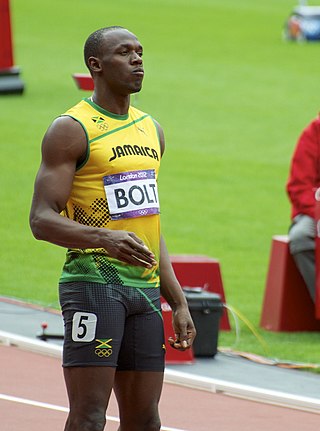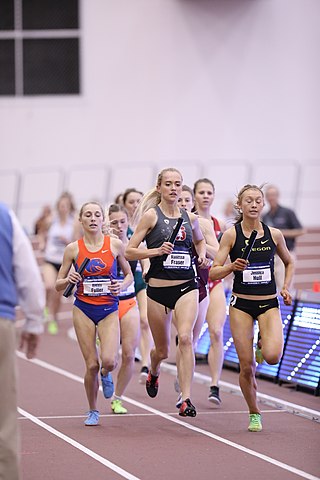
Sprinting is running over a short distance at the top-most speed of the body in a limited period of time. It is used in many sports that incorporate running, typically as a way of quickly reaching a target or goal, or avoiding or catching an opponent. Human physiology dictates that a runner's near-top speed cannot be maintained for more than 30–35 seconds due to the depletion of phosphocreatine stores in muscles, and perhaps secondarily to excessive metabolic acidosis as a result of anaerobic glycolysis.

Stanford Bermond Routt is a former American football cornerback. After playing college football for Houston, he was drafted by the Oakland Raiders in the second round of the 2005 NFL Draft. He played for the Raiders for seven seasons from 2005 to 2011. He also played for the Kansas City Chiefs and Houston Texans.
The 40-yard dash is a sprint covering 40 yards (36.576 m). It is primarily run to evaluate the speed and acceleration of American football players by scouts, particularly for the NFL draft but also for collegiate recruiting. A player's recorded time can have a heavy impact on his prospects in college or professional football. This was traditionally only true for the "skill" positions such as running back, wide receiver, and defensive back, although now a fast 40-yard dash time is considered important for almost every position. The 40-yard dash is not an official race in track and field athletics, and is not an IAAF-recognized race.

The distance medley relay (DMR) is an athletic event in which four athletes compete as part of a relay. With its inclusion in the IAAF World Relays program, the IAAF announced on May 1, 2015 that the event would be an official world record event.
This is a list of the NCAA outdoor champions in the short sprint event. Generally that was the 100-yard dash until 1975, with the metric 100 meters being contested in Olympic years starting in 1932. Metrication occurred in 1976, so all subsequent championships were at the metric distance. Hand timing was used until 1973, starting in 1974 fully automatic timing was used.
This is a list of the NCAA outdoor champions in the 220 yard dash until 1975, and the metric 200 meters being contested in Olympic years starting in 1932. Metrication occurred in 1976, so all subsequent championships were at the metric distance. Hand timing was used until 1973, starting in 1974 fully automatic timing was used.
This is a list of the NCAA outdoor champions in the 440 yard dash until 1975, and the metric 400 meters being contested in Olympic years starting in 1932. Metrication occurred in 1976, so all subsequent championships were at the metric distance. Hand timing was used until 1973, starting in 1974 fully automatic timing was used.
This is a list of the NCAA outdoor champions in the mile run until 1975, and the metric 1500 meters being contested in Olympic years starting in 1932. Metrication occurred in 1976, so all subsequent championships were at the metric distance. Hand timing was used until 1973, starting in 1974 fully automatic timing was used.
This is a list of the NCAA outdoor champions in the 3 mile run until 1975, and the metric 5000 meters being contested in Olympic years starting in 1932. Metrication occurred in 1976, so all subsequent championships were at the metric distance. Hand timing was used until 1973, starting in 1974 fully automatic timing was used.
This is a list of the NCAA outdoor champions in the 6 mile run until 1975, and the metric 10000 meters being contested in Olympic years starting in 1932. Metrication occurred in 1976, so all subsequent championships were at the metric distance. Hand timing was used until 1973, starting in 1974 fully automatic timing was used.
This is a list of the NCAA outdoor champions in the 3000 meters steeplechase. Hand timing was used until 1973, starting in 1974 fully automatic timing was used.
This is a list of the NCAA outdoor champions in the 440 yard hurdles until 1975, and the metric 400 meters hurdles being contested in Olympic years starting in 1932. Metrication occurred in 1976, so all subsequent championships were at the metric distance. Hand timing was used until 1973, starting in 1974 fully automatic timing was used.
This is a list of the NCAA outdoor champions in the 4x110 yard relay until 1975, and the metric 4x100 meters relay being contested after metrication occurred in 1976. Hand timing was used until 1973, starting in 1974 fully automatic timing was used.
This is a list of the NCAA outdoor champions in the 4x440 yard relay until 1975, and the metric 4x400 meters relay being contested after metrication occurred in 1976. Hand timing was used until 1973, starting in 1974 fully automatic timing was used.
This is a list of the NCAA outdoor champions in the 120 yard high hurdles until 1975, with the metric 110 meters hurdles being contested in Olympic years starting in 1932. Metrication occurred in 1976, so all subsequent championships were at the metric distance. Hand timing was used until 1973, starting in 1974 fully automatic timing was used. The height of the hurdles and the spacing between the two races are identical, 110 meters is 29 cm just slightly under a foot longer from the last hurdle to the finish line.
This is a list of the NCAA outdoor champions in the 220 yard low hurdles until they were discontinued in 1959. Hand timing was used throughout the duration of this event. The event was not held in the Olympic years of 1924, 1948, 1952 and 1956, in favor of the 400 metres hurdles. It was held in the Olympic year of 1936, and was part of Jesse Owens multi-world-record-breaking meet.
This is a list of the NCAA outdoor champions in the 2 mile run until the event was terminated in 1958 in favor of the 5000 meters. Starting in 1936, the event was substituted for the 5000 meters Olympic distance. Hand timing was used throughout the duration of this event.
This is a list of the NCAA indoor champions in the short sprint event. Generally that was the 60 yard dash until 1983, 55 meter dash 1984 to 1999, and the 60 meters being contested thereafter. Hand timing was used until 1975, starting in 1976 fully automatic timing was used.
This is a list of the NCAA indoor champions in the Mile run. This is the only event on the NCAA schedule that has not transitioned from imperial measurements to metric. Hand timing was used until 1975, starting in 1976 fully automatic timing was used.
This is a list of the NCAA indoor champions in the short "high hurdle" event. Generally that was the 60 yard hurdles until 1983, 55 meters 1984 to 1999, and the 60 meters being contested thereafter. Hand timing was used until 1975, starting in 1976 fully automatic timing was used.



